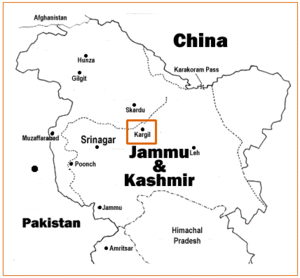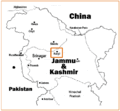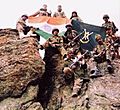Kargil War facts for kids
Quick facts for kids Kargil War |
|||||||||
|---|---|---|---|---|---|---|---|---|---|
 Location of the conflict |
|||||||||
|
|||||||||
| Belligerents | |||||||||
| Commanders and leaders | |||||||||
(President of India) (Prime Minister of India) (Chief of the Army Staff) (Vice Chief of the Army Staff) (Chief of the Air Staff) |
(President of Pakistan) (Prime Minister of Pakistan) (Chief of the Army Staff) (Chief of the General Staff) |
||||||||
| Strength | |||||||||
| 30,000 | 5,000 | ||||||||
| Casualties and losses | |||||||||
|
Indian official figures
Pakistani claims
|
Independent figures
Pakistani figures
Indian claims
|
||||||||
The Kargil War, also called the Kargil conflict, was a fight between India and Pakistan. It happened from May to July 1999 in the Kargil district of Kashmir. This area is along the Line of Control (LoC). In India, this conflict is known as Operation Vijay, which means "Victory". This was the name for the Indian military plan to clear the Kargil area.
The Indian Air Force also helped the Indian Army during the war. Their goal was to remove Pakistani soldiers and other fighters from Indian positions. These positions were along the Line of Control. This air operation was called Operation Safed Sagar, meaning "White Sea".
What Caused the Kargil War?
The war started because Pakistani troops secretly crossed into Indian territory. They were disguised as local fighters from Kashmir. They took over high mountain positions on the Indian side of the Line of Control. This line acts as the unofficial border between India and Pakistan in Kashmir.
At first, Pakistan said the fighting was only by Kashmiri rebels. But later, documents found on fallen soldiers showed that Pakistani military forces were involved. Pakistan's Prime Minister and Army Chief also confirmed this. The Indian Army, with help from the Indian Air Force, took back most of these positions. Other countries then put pressure on Pakistan. Because of this, Pakistani forces had to leave the remaining Indian areas.
Fighting in the Mountains
The Kargil War is a recent example of fighting in very high mountains. This kind of war is called mountain warfare. It created big challenges for both sides to move supplies and soldiers. This war is also special because it was a direct fight between two countries that have nuclear weapons.
India had tested its first nuclear weapon in 1974. Pakistan had been secretly working on its own nuclear weapons. They tested theirs in 1998, just two weeks after India did a second series of tests.
Images for kids
-
The town of Kargil is in a very important location.
-
IAF MiG-21 planes were used a lot in the Kargil War.
-
Nawaz Sharif was the Prime Minister of Pakistan at that time. A few months later, a military takeover removed him from power.
-
The main entrance of the Kargil War Memorial built by the Indian Army in Dras, India.
See also
 In Spanish: Guerra de Kargil para niños
In Spanish: Guerra de Kargil para niños











